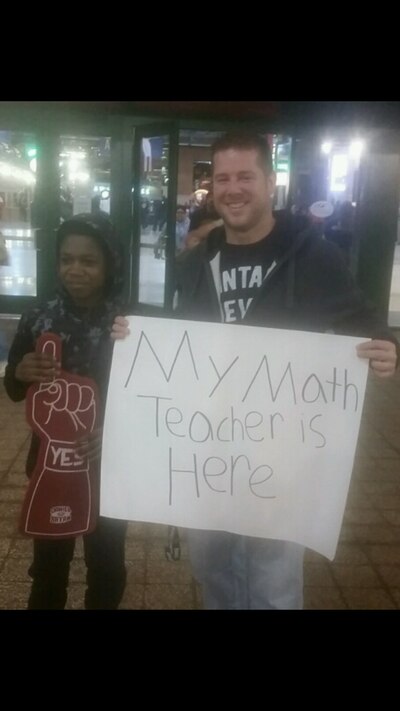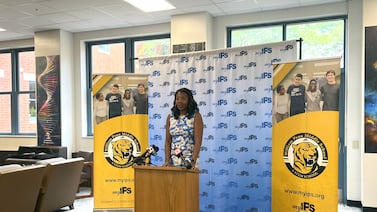As a senior at Indianapolis’ Ben Davis High School, Jacob Gregory enrolled in an Exploratory Teaching program. He thought of it as an easy way to leave school for a few hours, but it ended up sparking “an unknown interest in teaching,” he said.
Today, the sixth grade math and science teacher at McKinley Elementary School is a quiet rock star. The school’s sixth grade growth scores in math are at nearly 58%, meaning more than half of the students met their individual growth targets on the state’s ILEARN test.
That kind of growth is well above the state average, and it’s one reason why McKinley Elementary had among the highest improvement rates in state test scores last year.
Throughout the pandemic, Gregory held his students to high expectations, whether they were learning in person or virtually.
“I never looked for ‘gaps’ or ‘learning loss.’ I never changed my teaching style or ‘geared it down’ just because we were sitting behind 12-inch screens,” he said. “I knew I could deliver quality instruction to my virtual and in-person students; it was just a matter of how I was going to pull it off virtually.”
In an interview with Chalkbeat, Gregory shared his insights on the challenges of middle school math, his advice for his younger self, and how he uses basketball to get kids excited to learn.
This interview has been lightly edited for length and clarity.
How do you engage middle schoolers or get them excited about math?
I stress the importance of every little thing we do in our classroom — every lesson, every assignment, every test — understanding that we are all building toward our end goals and being fully prepared for the next school year. We really build a “rally cry” and celebrate the successes of everyone. It’s that buy-in that drives each sixth grader to want to do their best in math. Without calling it “competition,” they want to not only meet their goals but to do as well, if not better, than their peers.

Your principal has noted your math growth scores. How did you achieve that?
I cannot pinpoint one thing that would be the root of our growth. I’ve always wanted to meet each student exactly where they are academically and build on that. I’ve said it often: Everyone starts a marathon at the same spot, but not everyone runs at the same pace or finishes at the same time. Just like in our class, we all must get to the finish line somehow.
I’ve immersed myself in our Eureka Math program and have been able to become an expert (with still plenty to learn) in where it begins and where it wants our students to finish.
We use a program called Plickers every morning for our spiral review. It is five questions I’ve constructed that allow us to both review previous content and continue to work on current classroom content. I think sixth grade math students have so much to learn over the course of 180 days it becomes very difficult for them to remember what they learned in August to answer a standardized test question in April. Our Plickers allows us to never forget our “old friends” and keep them fresh throughout the year.
You lead an NBA Math Hoops club — can you tell me more about that?
NBA Math Hoops is our math club. It’s a board game and mobile app curriculum that allows students to learn fundamental math skills through basketball using current NBA and WNBA players. Math Hoops improves important math and social-emotional skills.
We recently had the opportunity to take some of our Math Hoops MVPs to a Pacers game and had a great experience. We will be heading to Gainbridge Fieldhouse on March 15 with our sixth grade to play NBA Math Hoops LIVE with the STEM nonprofit Learn Fresh and Pacers/Fever special guests.
What best describes your teaching method?
Everything has structure, a place, and a purpose in my classroom. There is no wasted motion or opportunities for learning. My students could tell any guest exactly how my class is run and in what order we do things.
What was the hardest moment on the job for you in all of your career – and how did you overcome it? What advice would you give to other teachers facing challenges?
Not finishing our 2020 school year. Period. Nothing else. That group of students I had was very special and will always be dear to my heart because we never got to the finish line together. I feel COVID took something special away from us.
I was once told in a curriculum training that it was “one day, one lesson,” which sounds bad when you think about “What if a student didn’t learn in that lesson?” or “What if there is something we didn’t get to?” But I started to think about that as a whole, and no matter how bad you think that day and that lesson went, there’s always tomorrow and that next lesson.
What part of your job is most difficult?
Keeping my job at my job. I have a tough time detaching from work. My wife gets to hear all the stories, all the successes, the failures, and the struggles.
It has taken 17 years, and I’m sure I still can’t quite grasp it, for me to understand that these are children who are often dealing with adult-type issues. A lot of time, their biggest concern that day is not how to divide fractions or find the surface area of a rectangular prism.
If you could go back in time to your first year of teaching, what would you tell yourself then, knowing what you know now?
“Back To The Future” is my all-time favorite movie, so don’t tempt me with getting in a DeLorean and going 88 miles per hour. I would tell myself: Don’t sweat the little things; there will be strikes and gutters, ups and downs. At the end of the day, if a student learned one new thing, you did your job.
Amelia Pak-Harvey covers Indianapolis and Marion County schools for Chalkbeat Indiana. Contact Amelia at apak-harvey@chalkbeat.org.








